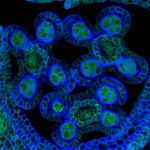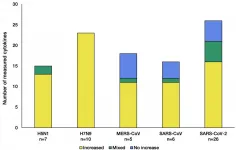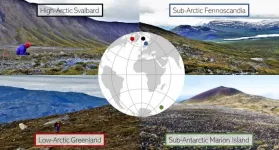Walking away from the beat - why police officers are voluntarily leaving in large numbers
2021-03-01
(Press-News.org) Home Office data shows the number of police officers voluntarily resigning from the force in England and Wales has more than doubled in the last eight years.
Scant attention has been paid to the reason for this mass exodus. Until now. Researchers from the University of Portsmouth studied government statistics, and discovered the numbers of officers voluntarily resigning from the police service is rising - from 1,158 in the year ending March 2012 to 2,363 in the year ending March 2020. The figure amounts to 1.83 per cent of the total police officer population in England and Wales up from 0.86 per cent eight years ago.
Dr Sarah Charman, from the Institute of Criminal Justice Studies at the University of Portsmouth, led the study. She says: "By any measure this rise is steep and troubling, especially when coupled with a more complex policing landscape requiring knowledge and experience. It seems more important than ever therefore to provide an insight into a relatively under-researched aspect of policing - why police officers resign prematurely from the police service through what could be argued to be avoidable turnover."
The researchers then carried out a small-scale study of officers who had resigned voluntarily from one medium-sized police force in England between November 2014 and June 2019. The study was published today in the journal Policing and Society. The data from this survey of 46 police leavers plus 27 interviews suggests a number of contributory factors, the majority relating to three areas:
1. Poor leadership and management was cited as the most regular theme in answers as to why officers left the police service voluntarily. Perceptions of poor management were often enhanced by concerns about powerful policing occupational cultures. Comments referred to management at all levels, whether immediate line management, middle management or senior management within the organisation. This related to both levels of supervision and levels of support. For example:
'The force regularly forcibly moved you between teams and roles. This was through no fault of your own, but through poor demand planning'
'Lack of robust supervisory support'
2. The research showed that police officers who had left the organisation felt an overriding sense of organisational 'injustice', to such an extent that that the delicate balance between employer and employee had been breached. Participants felt that they had little or no control or autonomy over their job, their role or their future - they felt that they lacked a 'voice' within the organisation. A lack of access to promotions and unsustainable workloads, with an inability to maintain a work/life balance had a negative impact. The comments related to these factors, the most frequently mentioned of these were related to a perceived lack of promotion and progression opportunities.
'Absolutely no prospect of lateral career progression or promotion'
'The talent management and progression in policing is very poorly developed'
3. Personal factors were cited by 25 per cent of participants as being in their top three reasons for leaving. Almost half of these former officers referred to difficulties in managing caring responsibilities while doing the job. After poor leadership and management, this was the second most cited reason for leaving the police service.
'Relentless working hours - expectation as a single parent to leave my children at home alone all weekend to fit in with the working pattern'
'Having my first baby...made to feel like it would be too tough to come back into a Detective role'
Dr Charman says, "With policing in England and Wales undergoing one of the biggest recruitment drives in modern history and the focus for the Home Office firmly back in favour of retention, an understanding of what contributes to a decline in organisational commitment and ultimately to avoidable turnover within policing is crucial. This research has endeavoured to understand this relationship and its findings have important implications for the police service in England and Wales."
Researchers conclude that internal organisational issues are far more relevant to an individual officer's intention to leave policing than occupational factors. While there are also relevant external factors, particularly in relation to 'excessive' workloads, which do clearly impact on levels of dissatisfaction, the focus for change would appear to be in a consideration of how the social exchange factors, which are so crucial to an enhanced sense of organisational commitment can be rebalanced equitably to take account of both the individual needs of staff in addition to organisational demand.
INFORMATION:
Notes for editors:
1. A copy of the paper Voluntary resignations from the police service is available here
2. The University of Portsmouth is a progressive and dynamic university with an outstanding reputation for innovative teaching and globally significant research and innovation.
It was rated 'Gold' in the UK government's Teaching Excellence Framework (TEF) and was ranked in the top 150 under 50 in the world according to the Times Higher Education rankings.
The University's research and innovation culture is impacting lives today and in the future and addressing local, national and global challenges across science, technology, humanities, business and creative industries. http://www.port.ac.uk/
For further information:
Emma Gaisford, Media Officer, University of Portsmouth, email: emma.gaisford@port.ac.uk
ELSE PRESS RELEASES FROM THIS DATE:
2021-03-01
New research will enhance corona safety during cruises and help cruise lines to again attract passengers onboard
Researchers within Cell Biology and Industrial Management at Åbo Akademi University have developed models aimed at ensuring corona safety during cruises.
The coronavirus pandemic stopped the cruise industry more or less completely. Major international cruise lines, such as Royal Caribbean Group and Carnival Corporation, largely suspended their cruises during 2020, which resulted in practically zero turnover and losses amounting to billions.
Upon assignment by Business Finland, an interdisciplinary research team has been working to find solutions for managing the current crisis ...
2021-03-01
A lot of us recycle our old textiles, but few of us know that they are very difficult to re-use, and often end up in landfills anyway. Now, researchers at Lund University in Sweden have developed a method that converts cotton into sugar, that in turn can be turned into spandex, nylon or ethanol.
WATCH: New method transforms old cotton into glucose
https://www.youtube.com/watch?v=B1V--prLs08
Every year, an estimated 25 million tonnes of cotton textiles are discarded around the world. In total, 100 million tonnes of textiles are thrown out. In Sweden, most of the material goes straight into an incinerator and becomes district heating. In other places, it is even worse, as clothes usually end up in landfills.
"Considering that cotton is a renewable ...
2021-03-01
TAMPA, Fla. - Genetic alterations of the KRAS gene are some of the most common mutations in lung cancer patients, but unfortunately these patients have few effective treatment options. Drugs that target the G12C mutation in KRAS have shown some activity in lung cancer; however, alternative signaling pathways are often activated that bypass the KRAS inhibitor, resulting in drug resistance. In a new article published in Clinical Cancer Research, Moffitt Cancer Center researchers show that various subtypes of lung cancer cells activate different signaling pathways in response to KRASG12C inhibitor treatment. These results may help identify potential combination therapy approaches and guide ...
2021-03-01
Atmospheric carbon dioxide (CO2) is a major driver of global warming, but this gas could also serve as a valuable resource. Researchers at KAUST have developed an efficient catalyst that uses light energy to convert CO2 and hydrogen into methane (CH4). This counteracts the release of CO2 when methane is burned as a fuel.
Many researchers worldwide are exploring ways to convert CO2 into useful carbon-based chemicals, but their efforts have been limited by low efficiencies that restrict the potential for large-scale application.
"Our approach is based on the synergistic combination of light and heat, known as the photothermal effect," says postdoc Diego Mateo. He explains that the heat is generated by the interaction of light with the catalyst, ...
2021-03-01
Spikes in temperature can affect a plant's fertility, resulting in a reduction of yield and economic loss
How plants can protect themselves from stress has been studied by a consortium led by the University of Warwick
Two argonaute-like proteins protect the plant's fertility, understanding these proteins is critical to safeguarding crop production
As Temperatures rise due to global warming the need to protect plants from stressful conditions has increased, as stress can cause a loss in yield and cause further impact economically. A consortium led by the University of Warwick have successfully identified ...
2021-03-01
Respiratory viruses such as SARS-CoV-2 (causing COVID-19) can often catalyse an overactive immune response that leads to a life-threatening cycle, known as a cytokine storm. Analysing cytokine responses from patients infected with SARS-CoV-2 and similar common respiratory viruses has unearthed glaringly important differences in how SARS-CoV-2 affects cytokines compared to other common respiratory viruses.
The comprehensive data resource aims to help specialists identify better treatments and diagnosis of underlying causes that can cause the deadly cytokine storm.
Scientists at the ...
2021-03-01
In order to avoid the occurrence of such effects, the Federal Institute for Health Protection of Consumers and Veterinary Medicine (BgVV) recommended guidance values for maximum THC levels in various food groups in 2000. The guidance value for beverages was given as 0.005 mg/kg, for edible oils with 5 mg/kg and for all other foods with 0.150 mg/kg. In 2018, the BfR came to the conclusion that these values no longer correspond to current scientific knowledge.
Instead, the BfR recommends that the toxicological assessment of hemp-containing foods be carried out on the basis of the acute reference dose (ARfD) of 1 microgram Δ-THC/kg body-weight derived by the European Food Safety Authority (EFSA) in 2015. The ARfD specifies the estimated maximum quantity ...
2021-03-01
DNA nanotechnology - the research field using DNA molecules as building material - has developed rapidly during recent years and enabled the construction of increasingly complex nanostructures. DNA nanostructures, such as DNA origami, serve as an excellent foundation for nanocarrier-based drug delivery applications, and examples of their use in medical treatments have already been demonstrated. Although the stability of such DNA nanostructures under physiological conditions can be improved, little is known about their digestion by endonucleases, which, found everywhere in our blood and tissues, are responsible for destroying foreign DNA in our bodies.
To tackle this emerging question, a ...
2021-03-01
Scientists have taken a significant step forward in their search for the origin of a progressive eye condition which causes sight loss and can lead to corneal transplant.
A new study into keratoconus by an international team of researchers, including a University of Leeds group led by Chris Inglehearn, Professor of Molecular Ophthalmology in the School of Medicine, has for the first time detected DNA variations which could provide clues as to how the disease develops.
Keratoconus causes the cornea, which is?the clear outer layer?at the front of the eye, to thin and bulge outwards into a cone shape over time, resulting in blurred vision and sometimes blindness. It usually emerges in young adulthood, often with lifelong ...
2021-03-01
Researchers are in the search for generalisable rules and patterns in nature. Biogeographer Julia Kemppinen together with her colleagues tested if plant functional traits show similar patterns along microclimatic gradients across far-apart regions from the high-Arctic Svalbard to the sub-Antarctic Marion Island. Kemppinen and her colleagues found surprisingly identical patterns.
It is widely known that global vegetation patterns and plant properties follow major differences in climate. Yet, it has remained a mystery how well the same rules can be applied at very local scales. Are responses to the environment similar in plant communities ...
LAST 30 PRESS RELEASES:
[Press-News.org] Walking away from the beat - why police officers are voluntarily leaving in large numbers



